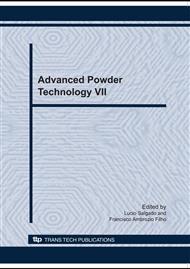p.739
p.746
p.752
p.757
p.765
p.771
p.777
p.784
p.788
Evaluation of the Behavior of Brazilian Bentonite Clays with Different Quantity of Quaternary Ammonium Salt
Abstract:
Paraíba is the main natural bentonite producing state of Brazil. Besides the advantage of abundance of bentonite clays, its transformation in organoclay is a simple method and there is only little study about the commercialization of Brazilian organoclays. In this work, Brazilian bentonite clay was organophilized with different quantity of a quaternary ammonium salt, such as 100, 125 and 150 wt.% in relation to Cationic Exchange Capacity (CEC) of the clay. The clays were characterized by X-ray Fluorescence (XRF), X-ray Diffraction (XRD), Thermogravimetry (TG) and Nuclear Magnetic Resonance (NMR). It was observed that with increasing amount of salt the degree of dispersion of the clay increased, leading in some cases to the delamination of the clay layers and its loss of thermal stability.
Info:
Periodical:
Pages:
765-770
Citation:
Online since:
October 2010
Price:
Сopyright:
© 2010 Trans Tech Publications Ltd. All Rights Reserved
Share:
Citation:


